Garden Bed Potpourri
Fruits, welcome vegetables! Garden beds are nearly finished and they are lively.
The soil in all of the garden beds is recycled from the soil taken out to make the path. We outlined where garden beds would go and the excavators dumped soil in those spaces. This tactic saved labor but 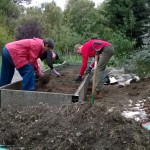 there was still a lot of soil moving and leveling needed.
there was still a lot of soil moving and leveling needed.
We started by collecting rubble from nearby construction sites. Torn up driveways are best because the pieces of urbanite are fairly thin. The first bed was a mound bed: piled up dirt and then bordered with rubble. The mound method costs nothing and takes the least amount of labor. The blueberry mounds do not even have a border. You can see we went a bit overboard with the vetch/rye grass cover crop. In the spring, we will try the no-till method of bed preparation: cut the overwintered plants at ground level just as they start to bloom but before they go to seed.
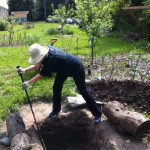
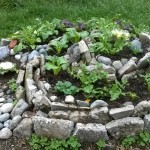 Next came Liz’s herb spiral. The spiral has a second objective in addition to providing tasty mustard greens. Volunteers dug down below the ubiquitous hard subsoil layer, in an attempt to improve drainage. Logs were dropped into the big hole before we backfilled. Time will tell whether this tactic will reduce the amount of standing water in that area during the winter months.
Next came Liz’s herb spiral. The spiral has a second objective in addition to providing tasty mustard greens. Volunteers dug down below the ubiquitous hard subsoil layer, in an attempt to improve drainage. Logs were dropped into the big hole before we backfilled. Time will tell whether this tactic will reduce the amount of standing water in that area during the winter months.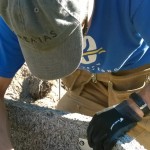
Then came the fancy beds; the Faswall-framed beds. The Faswall 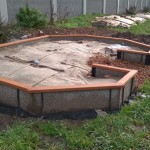 material is used to make homes but also can be fashioned into garden bed panels. Recycled wood is ground up, concrete is added and then the material is mineralized. There are no resins. These panels cost less than cedar. The only problem was, someone requested an Octagon. Due to the angles, this bed took four times as many hours to construct! Still, it’s rather unique.
material is used to make homes but also can be fashioned into garden bed panels. Recycled wood is ground up, concrete is added and then the material is mineralized. There are no resins. These panels cost less than cedar. The only problem was, someone requested an Octagon. Due to the angles, this bed took four times as many hours to construct! Still, it’s rather unique.
More recently, we are working on grape trellises. A volunteer offered up old steel pipe from her 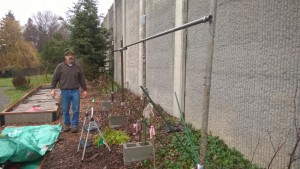 yard. We had to cut 11 pieces with a pipe cutter. The job is quiet and rather meditative … round and round and, well, finally the end pops off. Some of the pipe was so rusty that the pipe cutter slid around a bit. We had to buy hose clamps, Quikrete, wire and turnbuckles. These material costs were minimal.
yard. We had to cut 11 pieces with a pipe cutter. The job is quiet and rather meditative … round and round and, well, finally the end pops off. Some of the pipe was so rusty that the pipe cutter slid around a bit. We had to buy hose clamps, Quikrete, wire and turnbuckles. These material costs were minimal.
We applied for and earned a compost donation from Cedar Grove and only had to pay for delivery. Gardeners are deliberating how much to add to the garden beds. The new gardeners are encouraged to experiment and document so we can determine what, if any, soil amending is needed. One of our goals is to minimize inputs and outputs.
There is still one garden bed open! Remember, you can co-garden with a more experienced gardener if you don’t have much experience.
Ruth
Sat, Feb 6, 2-4, Work Party
Sat, Feb 13, 1-3, Pruning Class
Sun, Feb 21, 2-4, Work Party
Sat, Mar 5, 2-4, Work Party

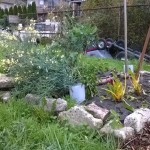
Well done!
I would be interested in using the available bed and don’t mind sharing. I moved recently and am looking for a space to grow veggies! This could provide the incentive for me to become a more regular volunteer.